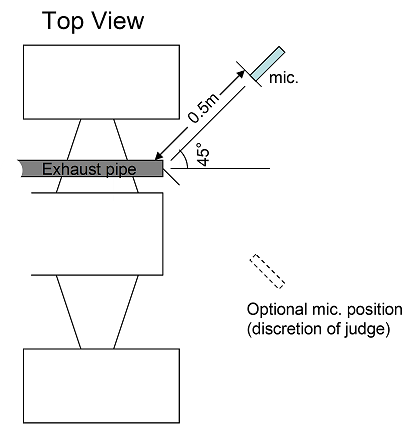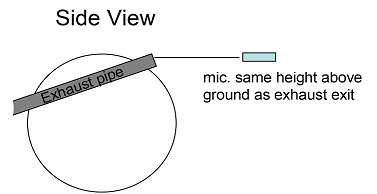Last Updated: January 18, 2024
EVENT CAPTAINS: Gary Newton, Greg McConville
ON-SITE LOCATIONS: North of the Fuel Station
Description:
No vehicle is permitted to perform Noise testing until it has: a) passed Tech Inspection and, b) passed the Tilt Table Test. Proof of this is the two “tech” stickers, which must be applied to the car. Then teams can proceed to Noise where the noise level will be tested, if passed, a 3rd sticker will be applied to indicate Noise Compliancy. Then teams can proceed to the Brake test for the 4th and final tech sticker. Once all 4 stickers are completed then a vehicle is approved to compete in all dynamic events.
Noise Test Event Description
The static sound level test shall occur at a designated test station on a warmed-up vehicle. The vehicle will be placed in the station with the engine running and the transmission in neutral. The sound level meter will be positioned 0.5m from, and level with, each exhaust outlet. The microphone will be positioned at an angle up to 45 degrees from the outlet in the horizontal plane (see drawings) and be un-obstructed.
There are two steps to the noise test.
- With the engine idling, the measurement must not exceed 103 dBC. If the team passes this test, the run up test will be run. If a team fails idle they must exit the station.
- With the engine at the designated test speed, the measurement must not exceed 110 dBC. The designated test speed is approximately 3/4 of the maximum engine speed as calculated by the SAE published formula.
In the case of dual exhausts, both exhausts will be tested with the loudest one being the basis for judgment. Meters are calibrated and will be checked and verified on-site on a regular basis! The placement of the microphone and the reading of the meter by the official is final and not open for debate/protest.


PLEASE NOTE – If your vehicle does not have a working tachometer, it is the teams’ responsibility to come to the noise area prepared with ALL necessary tools ready for a tachometer reading (laptops, gauges, etc…). The target test speed is set by SAE and is published in advance. Test speeds will be rounded to the nearest 500. It is calculated by taking 2X stoke in mm and dividing it into 914.4X1000. If you have a rev-limiter that interferes with you being able to reach the target test speed you must disengage it or set it higher. ALL TEAMS MUST HIT THE TARGET TEST SPEED!
Any exceptions to test speed must come with note from tech approving it.
Noise level can be measured at any time during the dynamic events. Penalties may be assessed if the sound level exceeds the mandated maximum, and noise sticker can be removed by officials.
Vehicles may be forced to return to this station for re-certification should the officials deem it necessary. Re-certification may be required if work is performed on the vehicle’s exhaust system, or if the vehicle is involved in an incident that results in vehicle damage.
At all times, drivers must be wearing complete and proper safety equipment and proper safety rules must be maintained.
Safety guidelines for the Noise area:
- Only one car at a time in Noise test station. Do not allow a second car into the station until the last one has completed its exit.
- Only the vehicle crew and the driver are allowed to enter the Noise. All must have dynamic passes at each visit.
- Do not attempt certification of any vehicle without enough workers. Three (3) workers recommended at Noise station.
- Never place yourself in the line of travel of any car. Stay well away from the “hot” area.
- Use water barriers/bike fencing for protection of workers and equipment.
- Fire extinguishers must be always with the car and crew.
- Use brooms and oil-dry as needed to keep area clean and dry.
- Any vehicle damage or contact must be reported to the station manager(s).
- No work will be allowed on the car inside the Noise test station. Car repairs and work must be performed outside of testing area. Specially designated areas will be set-up for this. Cars can then return to the test station at the discretion of the station manager.